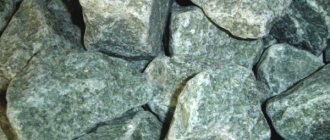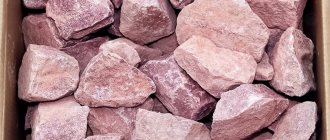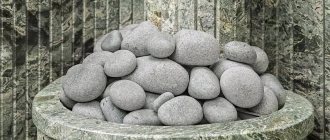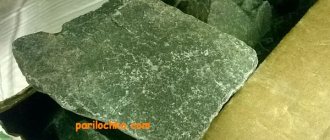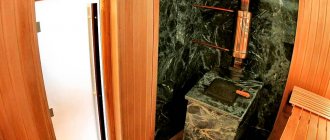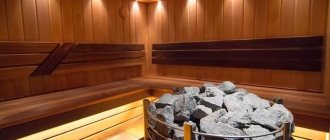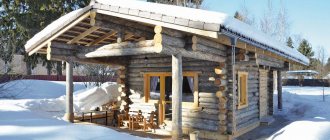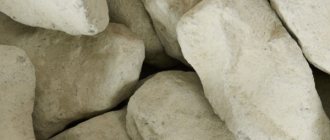Pros and cons of jadeite
The popularity of jadeite for saunas and baths is due to its physicochemical properties. Not all stones have such characteristics and are generally suitable for use in stoves and heaters. Minerals must have the following properties:
- environmental cleanliness;
- resistance to elevated temperatures;
- good heat capacity;
- optimal sizes (not too large, but not small);
- homogeneous composition and structure;
- absence of a large number of sharp corners.
Stones with harmful impurities and radiation are completely unsuitable. This is a serious contraindication for use in a steam room. When interacting with hot water, such stones will release dangerous substances, and if they have an unsuitable structure, they will split, “shooting” fragments. But even not all minerals specifically designed for steam are as useful as jadeite. It is difficult to find a stone more suitable for baths and saunas.
By changing the minerals in the steam room to jadeite, you will certainly notice the difference. At a minimum, the heater will heat up 30% longer. If before you heated a steam room for 1.5 hours, now it will take a couple of hours. But in return you get high-quality steam and all the healing properties, plus jadeite retains heat much longer than other stones.
Thanks to the excellent physical and chemical characteristics of this stone:
- A steam room with jadeite is used longer, since it maintains high temperatures for a long time, the quality of the steam remains unchanged.
- In the steam room it is easier to breathe, and aromatic substances are distributed better.
- When using jadeite, the steam is powerful and long-lasting, but easier to tolerate.
- The nobility of natural jadeite shades is conveyed to the setting.
- Due to its high thermal stability, the stone is not susceptible to sudden transitions from heat to cold, and therefore retains its beautiful appearance and characteristics for a long time.
- Even with frequent openings of the door, the temperature in the steam room with jadeite decreases by no more than 5 degrees, which does not reduce the amount of pleasure received from the bath.
- Vacationers are ensured safety, since the mineral does not contain harmful compounds or radiation.
Thus, having invested once in the arrangement of a jadeite stove, you will receive benefits in the form of a pleasant mood, healing steam. The stones will last at least 5–10 years, providing their healing properties. Due to its high strength, jadeite is resistant to many mechanical influences. The stone withstands shocks and collisions, therefore it lasts longer than other “bath minerals”.
Among the disadvantages of jadeite are the relatively high price and a large number of fakes, among which it can be difficult to identify a natural stone. But if you buy a high-quality mineral, you will rarely have to change it. This makes jadeite an economical stone for a steam room.
Use in the bath
Jadeite is successfully used for cladding walls, floors, partitions in saunas, baths, and swimming pools. It is better to entrust the work to a qualified craftsman, since cutting and laying heavy elements is quite difficult for a beginner. The quality of work will directly affect beauty and functionality.
The heater filler made of this material produces soft steam. It is light, does not overload the body, and is quickly formed even from a small amount of water. However, when directly heated, jadeite rarely lives longer than six months. For long-term operation, you need to mix the rock with diabase or arrange a substrate.
Most stones do not like open fire, and to at least somehow protect the stone, fill the first layer with cast iron cores. Cast iron will take the brunt of the impact, and the stones will last much longer.
It is much cheaper and easier to replace the “protective” material than the mineral itself.
No less common is massage with small pieces of jadeite. Only well-polished stones are used. From the touch of heated “pellets” the body relaxes and fills with energy. Point placement on painful areas helps relieve inflammation and creates an anesthesia effect.
Varieties of jadeite
Extraction of jadeite is a very labor-intensive process, since its deposits are often located in inaccessible areas. This explains the prices for the stone. Currently, the extraction of different types of jadeite based on color, type of inclusions and texture has been established.
Based on their shade and composition, there are two types of stone:
- Imperial is a transparent stone of very high quality and emerald green color.
- Utility is an opaque green stone. A popular and cheap category of jadeite.
- Commercial is an almost opaque green stone that has transparent veins. Most often used in jewelry.
There are also separate types of jadeite depending on their shape and texture. Each of them is suitable for its own purposes:
- chopped - has many natural irregularities and sharp edges, usually placed in a heater or oven;
- bunded - obtained after processing using special equipment, has a smooth and uniform structure, therefore it is more resistant to impacts and lasts longer compared to crushed stone, but costs more;
- polished - characterized by good smoothness and shine, bought mainly for decorating the steam room.
For a bath, it is better to choose pieces of mineral that are large in block size. This is the so-called bath jadeite, which is excellent for heating air and effective steam formation.
FAQ
Jadeite has changed its shade. Fake?
Natural jadeite can change color when heated. This is a feature of the mineral; you should not be afraid of it. On the contrary, it is better to use the “chameleon” effect in the decor.
What is the best way to fill the heater, taking into account the cast iron base?
Polished jadeite is best suited. But due to its high cost, you can practice the following life hack: fill most of it with cheaper crushed jadeite, and lay polished jadeite on top.
How to calculate how much jadeite I will need in the oven?
The minimum furnace load is approximately half the original volume. A 100 kg stove will require 50-60 kg of stone. There will simply be no effect from a smaller load.
What size jadeite is needed for an electric furnace?
It is optimal to take stones up to 6 cm.
What properties does jadeite have?
Due to its characteristics, jadeite is well suited for baths and saunas. Main properties of the mineral:
| Characteristic | Index |
| hardness | 7 on the Mohs scale |
| porosity | 0,3–0,5% |
| melting temperature | up to 1060 degrees Celsius |
| water absorption | 0,01–0,03% |
| specific heat | 0.88 J/kg K |
| thermal conductivity | 2.3-3.6 kcal |
Jadeite is characterized by a soothing green color, much like malachite or jade. And the external beauty of the greenish stone is complemented by excellent healing properties. The mineral has a pronounced tonic effect and also improves lung function.
As research by scientists from the Tomsk Research Institute has shown, when jadeite comes into contact with hot water in a steam bath, metasilicon acid is released. This silicon compound has a good effect on the skin and helps with the normal functioning of the respiratory system, which is especially important for residents of megacities who inhale large amounts of toxins every day.
The use of jadeite also has a stimulating effect on the entire body, improves tissue respiration, activates blood circulation, and promotes the removal of toxins.
Health effects
The healing properties of jadeite itself cause a lot of controversy among bath attendants.
- Some consider claims about the healing effects of the stone to be just a publicity stunt:
Quote ... there is no evidence that anyone was cured of hypertension or rheumatism only with its help. Just like scientific research of this kind...
- Others tend to attribute to the mineral a power that helps fight diseases:
The main thing for which the stone is valued is its healing properties. The steam obtained from the interaction of water with heated jadeite is disinfected and:
- stabilizes blood pressure;
- increases immunity;
- relieves pain in the spine and lower back;
- strengthens the heart muscle;
- stabilizes emotions;
- enhances potency;
- cleanses the blood;
- maintains muscle tone.
Other sources attribute positive effects to the mineral on the nervous system, blood vessels, and the relief of pain and spasms.
Expert opinion
Lovkachev Boris Petrovich
Bath master who knows everything about steaming
The only scientifically proven fact is that heated jadeite is a source of infrared radiation, which is good for skin rejuvenation and healing of small wounds.
Be that as it may, everyone unanimously agrees that high-quality steam is useful in itself. And the breed copes with this task perfectly.
How to choose a stone
Nowadays, counterfeits of jadeite have appeared on the bathing stone market. Criminals, under the guise of a semi-precious mineral, are trying to sell a less expensive related rock.
Externally, fakes are slightly reminiscent of jadeite in color, but they are easily recognized by poor processing or flaws on the surface. Therefore, when purchasing, you should carefully evaluate the minerals.
Attackers will offer you “kurumnik” - weathered stones that have broken away from the main rock. Counterfeits do not correspond to the class of elite jadeite and do not have its properties. Such stones do not withstand elevated temperatures well and break easily, which can be unsafe for people in the steam room. Therefore, we recommend not to chase low prices and take care of your health.
Recommendations for selection
Experts have some recommendations in their arsenal on how to distinguish high-quality jadeite:
- The friability of the mineral indicates that the rock lay in the upper layers for a long time and was in contact with the sun, wind, and organic compounds. It is also better to exclude such instances. They will quickly crumble, perhaps even before installation in the bathhouse.
- Naturally occurring jadeite cannot be scratched with a knife or quickly split with a hammer. Synthetic fakes will not pass this test.
- Decent jadeite can be of different colors, containing impurities of white, light gray, and blue. Units with dark gray, shiny streaks and spots should be excluded from purchase. The metallic reflection is characteristic of sulfide, which is harmful to health and smells bad when heated.
- The stone must be clean. Dirty specimens are not safe to produce steam.
- The natural mineral takes a long time to heat up by hand and cannot become warm in a couple of minutes.
- Larger displays will require larger sizes.
- Jadeite should be heavy; when tapped, the sound comes from the depths. Light weight, empty sound, like plastic, indicate a fake.
- The stone should not crumble in your hands. This indicates improper turning, looseness and fragility.
Expert opinion
Lovkachev Boris Petrovich
Bath master who knows everything about steaming
A certificate is required. If the seller refuses to present it, the buyer has every reason to believe that he is being offered a synthetic analogue under the guise of a natural fossil.
Video description
Here is an interesting video on how to wash bath stones:
In order for the steam room to function properly, it is necessary to correctly calculate the mass of stones. It is believed that there should be 5-6 kg of rock per square meter. Then the desired effect and maximum durability of the heater will be achieved.
Different types of stone differ in their service life
For stoves with a closed heater, a type that is more resistant to high temperatures is needed. In open stoves, the heating is less intense, so deciding which stones are better for the heater in the bathhouse is much easier.
Historical tales
Here we will try to tell how jadeite came to Europe, why in China it was (and is) valued along with the most expensive gems.
The Great and Terrible Conquest
People always want money. And more. Therefore, at the end of the 15th century, the king and queen of Spain decided that in India (according to rumors) precious stones and gold were practically lying on the ground. So let a couple of Spanish ships under the command of Columbus sail to a rich country and bring back that very gold and jewelry that is always in short supply.
The boats sailed and got lost along the way. Geographic maps were bad back then. Instead of Asia, we ended up in America, which no one had heard of at that time. But they stubbornly believed that they had reached Asia. Thus began the Conquest.
The locals greeted the Spaniards as dear guests. They gave us food and drink and showed us their cities and temples.
It was then that the Spaniards realized that they had come to the right place (in the sense that they found what they were going for).
I don’t want to say what the soldiers did to the aborigines. And most importantly, they robbed churches, dragging away everything that was not nailed down. Gold, amulets, Indian relics - everything was neatly stacked in the holds of the pot-bellied ships.
Among this stuff there were objects made of stone - greenish, white, pink. The stones had the property of relieving lower back pain, and the Spaniards called them piedra de ijada - “side stone”.
Then jadeite came to Europe.
The history of the mineral in the New World (Mesoamerica) is much longer. The stone was known to the Mayan, Aztec, and other aborigines from the 8th-4th centuries BC. This is confirmed by archaeologists who come across items made from jadeite. Ritual masks and jewelry were made from it. And also knives used by priests in ritual sacrifices.
Interesting: there are archaeological finds where jadeite teeth are inserted into skulls instead of ordinary, “native” teeth. It was probably prestigious back then.
Now about China. It is incorrect to believe that jadeite and jade have been held in special esteem in the Celestial Empire since time immemorial. At first it was jade.
But the artisans who processed the stone and made precious trinkets from it had trained eyes and hands. It was the masters who noticed that the jade obtained from Burma is not always the same. Some stones were denser and heavier. Treated, they shone better. These stones were jadeites.
But scientists determined that jade and jadeite are different gems only in the middle of the 19th century.
But even a description of the minerals will not help to understand what the mysterious Chinese soul found in jadeite.
